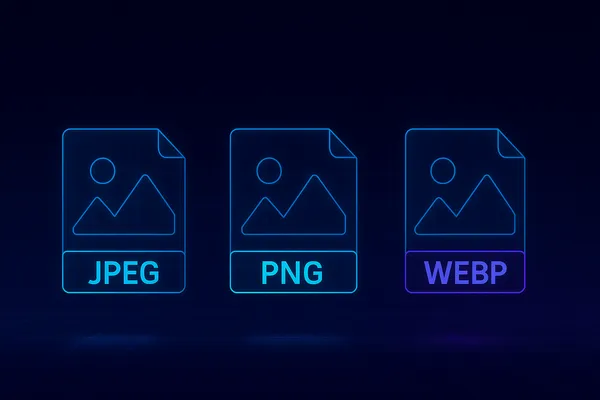Choosing the Best Image Format: JPEG, PNG, or WebP?
2025-04-02
- → Introduction
- → Understanding JPEG (Joint Photographic Experts Group)
- → Understanding PNG (Portable Network Graphics)
- → Understanding WebP
- → Key Differences Between JPEG, PNG, and WebP
- → When to Use JPEG
- → When to Use PNG
- → When to Use WebP
- → Examples and Comparisons
- → FAQ
- → References
Introduction

Choosing the right image file format is crucial for balancing quality, file size, and functionality, especially in web design and digital media. JPEG, PNG, and WebP are among the most popular formats, each with unique strengths and use cases. This article explores the characteristics, advantages, and disadvantages of these formats to help you decide which one suits your needs.
Understanding JPEG (Joint Photographic Experts Group)
History and Purpose
JPEG was introduced in 1992 as a standard for lossy compression of images. It was designed to reduce file sizes while maintaining acceptable visual quality, making it ideal for digital photography and web use .
Characteristics
- Compression: Lossy.
- Color Support: Millions of colors.
- Transparency: Not supported.
Common Uses
- Photographs.
- Web images where smaller file sizes are critical.
Advantages
- Highly efficient compression for photographic images .
- Widely supported across devices, browsers, and software .
Disadvantages
- Lossy compression can degrade image quality, especially after multiple edits .
- No support for transparency .
Understanding PNG (Portable Network Graphics)
History and Purpose
PNG was introduced in 1995 as a patent-free alternative to GIF. It was designed to provide lossless compression and support a broader color palette .
Characteristics
- Compression: Lossless.
- Color Support: 8-bit (PNG-8) or 24-bit (PNG-24).
- Transparency: Full alpha channel support.
Common Uses
- Logos and icons.
- Screenshots and graphics with sharp edges or text.
Advantages
- Preserves image quality with lossless compression .
- Supports transparency, making it ideal for layered designs .
Disadvantages
- Larger file sizes compared to JPEG, especially for photographs .
- Can be less efficient for web use due to file size .
Understanding WebP
History and Purpose
Developed by Google in 2010, WebP aims to combine the best features of JPEG and PNG while reducing file sizes. It supports both lossy and lossless compression .
Characteristics
- Compression: Both lossy and lossless.
- Color Support: High color depth.
- Transparency: Supported.
- Animation: Supported (similar to GIF).
Common Uses
- Websites prioritizing speed and performance.
- Images requiring transparency or animation.
Advantages
- Smaller file sizes compared to JPEG (25–34% smaller) and PNG (26% smaller) .
- Maintains good image quality while reducing bandwidth usage .
Disadvantages
- Limited support in older browsers and software, though compatibility is improving .
Key Differences Between JPEG, PNG, and WebP
| Feature | JPEG | PNG | WebP |
|---|---|---|---|
| Compression Type | Lossy | Lossless | Lossy & Lossless |
| Color Depth | Millions | 8-bit/24-bit | High |
| Transparency Support | No | Yes | Yes |
| File Size | Small | Large | Smallest |
| Browser Support | Universal | Universal | Increasing (96%) |
When to Use JPEG
- Photographs where small file size is important.
- Web images prioritizing fast load times.
- Scenarios where transparency is not required.
When to Use PNG
- Graphics requiring high detail or sharp edges.
- Images with transparency (e.g., logos).
- Screenshots or text-heavy visuals.
When to Use WebP
- Websites needing fast load times without sacrificing quality.
- Images requiring both transparency and small file sizes.
- Modern web applications targeting browsers that support WebP.
Examples and Comparisons
To illustrate the differences:
-
A photograph saved as:
- JPEG: Small file size but slight quality loss.
- PNG: Larger file size but no quality loss.
- WebP: Smallest file size with good quality.
-
A logo saved as:
- PNG: Preserves sharp edges with transparency.
- WebP: Smaller size with similar transparency support.
-
A web animation:
- WebP: Combines animation with superior compression compared to GIF.
FAQ
- What is the difference between JPEG, PNG, and WebP? JPEG uses lossy compression and is ideal for photographs, PNG offers lossless compression with transparency support, and WebP provides both lossy and lossless compression with smaller file sizes and transparency.
- When should I use JPEG? Use JPEG for photographs where small file size is important or when transparency is not required.
- When is PNG the best choice? PNG is best for graphics requiring high detail, sharp edges, or transparency, such as logos or screenshots.
- What are the advantages of WebP? WebP offers smaller file sizes than JPEG and PNG, maintains good quality, supports transparency, and works well for modern web applications.
- Does WebP have any limitations? WebP has limited support in older browsers, though compatibility is improving.
- How do I choose between these formats? Consider your needs: JPEG for photographs, PNG for detailed graphics with transparency, and WebP for optimizing web performance with smaller file sizes. Testing multiple formats may help you decide.
Conclusion
JPEG is ideal for photographic images where small file size matters. PNG excels in preserving detail and supporting transparency but has larger files. WebP offers the best of both worlds—smaller files with good quality—but requires modern browser support. Ultimately, your choice depends on your specific needs. Testing multiple formats may be necessary to find the perfect balance for your project.

